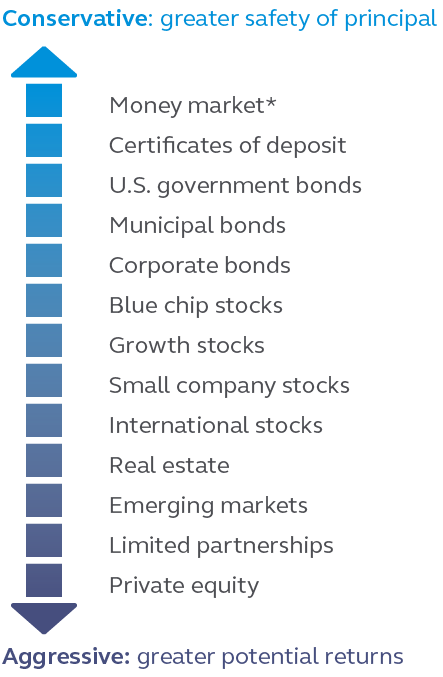3 steps to get started when you’re ready to invest

This is the year we’re facing ups and downs. These economic times make it even more important to set financial goals and ensure you have a spending, saving and investment strategy in place. This helps create adequate savings in case of an emergency and gets you on your way toward building your financial freedom in retirement.
A savings account is good for your short-term goals—the money you’ll need in the next three years.
For mid- and long-term financial goals, you’re going to need something with an engine. That’s what investing does—takes your saving strategy and puts an engine behind it.
- For money you need in three to five years, you have more time to weather market volatility, but you’re still likely sticking to more conservative, fixed income investments like you have more time to weather market volatility bonds.
- For savings you won’t need for five or more years, you may consider other investments to help spread risk and grow your money, like mutual funds, stocks, exchange traded funds (ETFs), and annuities—depending on your risk tolerance.
You’re already an “investor” if you contribute to your MPF account. But when you’re ready to venture beyond saving/investing in a retirement plan, here are three steps to get started.
1. Know your investment risk tolerance.
What’s the difference between investment types and asset classes? A lot centers around risk vs. return.
In general, the higher the potential for return (meaning a gain or loss on investment) the higher the potential for risk of loss—and vice versa.

Risk tolerance is how much you can keep the emotion out of investing. Healthy markets typically go up and down, but those short-term market changes can stir both excitement and regret.
Some people are more comfortable knowing they could lose money in the short run if there are possible gains in the long run. Others are more conservative, preferring less risk.
2. Diversify
Choosing a mix of investments from various asset classes helps manage risk. That’s because some investments tend to increase in value while others decrease.
For instance, stocks and bonds tend to move in opposite directions. If the value of your stock funds goes down, the value of your bond funds may increase.
It’s good to choose a mix of different investment options within each asset class. So within your stock investments, you could choose some lower-risk and some higher-risk. This can help you balance stock market volatility.
This is diversification. Over long periods, it might help you get a more consistent return. Diversifying means allocating your dollars across Hong Kong and international stock and bond markets, blending different investments in a single portfolio.
3. Adjust your investment mix over time.
In general, it’s good to have less risk as you get closer to your “end goal,” whether that’s retirement or another date.
That’s because if the market drops, you have less time to recover from losses. Giving up some potential for growth might be worth it in exchange for lower risk.
It’s also a good idea to rebalance your portfolio at least annually. Over time, some investments may grow more than others. After a while, your mix of investments isn’t the same as when you started. That could mean you’re taking on more risk (or less) than you originally intended.
Rebalancing takes everything back to your original mix, but if the change is more in-line with where you want to be, that’s OK, too. Most financial institutions can help you with rebalancing. Some do it automatically for you.
A few words about mutual funds or pooled investment options.
We all hear about people “making it big” on individual stocks. But it’s also easy to lose money on any single investment. It may be intimidating to think about researching and picking stocks or investments with the pressure of potentially losing money.
Mutual funds and other commingled investments (where investors’ contributions are “mutually” pooled) include a variety of investment types. That helps reduce risk.
Investment involves risks. This information is for general reference only.
The above content is retrieved from Principal Financial Group, Inc. website, and please refer to the Conditions of Use of the site.
https://www.principal.com/individuals/explore-life-money/3-steps-get-started-when-youre-ready-invest
